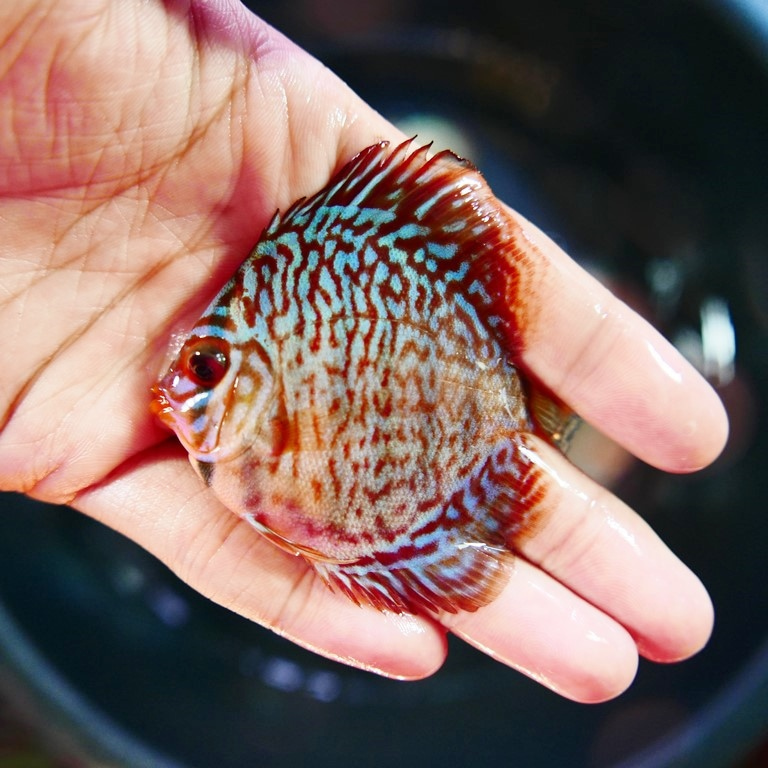
Strong biological and mechanical filtration along with weekly partial water changes are required to keep water quality high and water parameters consistent. If strong aquarium lighting is used for plant growth, be sure that the density of the plant life is great enough to provide shaded areas for the Red Turquoise Discus to retreat to when needed. Red Turquoise Discus should not be housed with aggressive or boisterous fish species or in aquariums with intense lighting or strong water currents. Discus can thrive in a wider range of water parameters as long as the changes are not sudden and the fish has adequate time to adjust to changing parameters. Water parameters should be very consistent with a pH near 6.8 to 7.2, temperature between 82° to 86° Fahrenheit with low to medium water currents. Red Turquoise Discus aquariums should closely resemble their natural Amazonian habitat with plenty of plants and branching root. It is also very important to maintain very consistent water parameters that have very little pH, temperature and dissolved mineral fluctuations. When keeping Red Turquoise Discus in the home aquarium, it is extremely important to replicate their natural surroundings and water parameters as closely as possible. The water also maintains very stable and consistent water parameters year round, including water temperatures that range between 80 to 86 degrees Fahrenheit both during the day and night.

The water is very low in mineral content, which makes it "soft" water with a low pH ranging from 4.0 to 7.0. In the wild, Red Turquoise Discus are found living in the upper tributaries of the Rio Negro and Rio Madiera along with the surrounding lakes and flood plains. Discus are very popular among intermediate to advanced fish keepers, and are widely considered to be one of the most rewarding and challenging to keep of the freshwater tropical community fish species available within the hobby. Over the years breeders have not only raised enough tank-bred specimens to largely fulfill the demand from the aquarium hobby, but have developed completely new color strains and patterns as well. Due to their popularity and the high price tag that they command, Discus are very popular with fish breeders. Ever since their introduction into the hobby to this day, Discus are considered one of the most colorful, demanding, rewarding and expensive of all tropical freshwater aquarium fish species. Should any food remain uneaten (unlikely) remove it.ĭiscus eat well, during feeding it is a good time to check your fish are well and is a good time to spot any potential problems from the fishes behaviour.Red Turquoise Discus originate from the Amazon River Systems of South America, where they were first imported into the aquarium hobby in the early 1930s.

Spread it around the aquarium so they all get a share and prevent a single Discus from sitting over the food and preventing the other getting a share, Discus are cichlids and will behave as such. Don't run under a tap to defrost as this will flush soe of the vitamin and mineral content away. We allow it to defrost to soft, break the portion into several smaller pieces and feed to fish. Never feed completely frozen as the fish will attack the food and can damage their mouths. A piece the size of a 10p coin is approximately 5g. Some hobbyist allow the food to softens lightly, cut into cubes and re freeze in an air tight tube. When established in your aquarium they will constantly look for food, but you need to resist and find a balance between the nutritional needs of the fish and maintaining water quality.īlisters are easy to portion as they are packed in 5g cubes, the slabs need breaking, this is easily done by scoring the frozen slab with a Stanley knife and breaking it, or cutting with secateurs. Discus 12 cm to 18 cm require 2g of Goodheart per day, per - fed over to or three feeds per day. Discus to 12 cm require 1.5g of Goodheart per day, per fish - fed over two or three feeds per day. Goodheart is available in 100 g blister packs and 500 g bulk slabs, it is available in three variations, Regular, Colour and Spirulina. It is a compete food and feeding your Stendker Discus correctly is essential. The food contains over 100 different vitamin, minerals, crustaceans, insect, vegetable matter.

Stendker Goodheart has been used and developed by the Stendker Hatchery since 1966.

Any Discus bought from us will have been fed Stendker Goodheart from the age of three weeks.


 0 kommentar(er)
0 kommentar(er)
